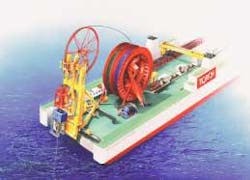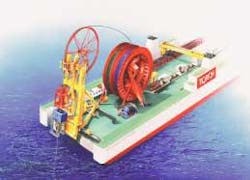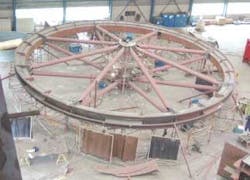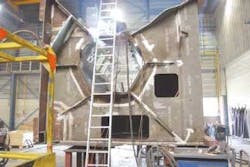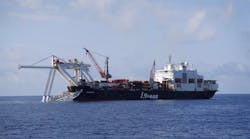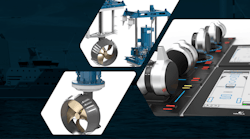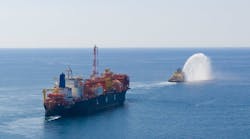Last summer, Torch Offshore commissioned Huisman Special Lifting Equipment to design and build a new J-lay pipelay system for the Midnight Express. The latter, formerly a 500-ft long lash container carrier vessel Smit Express, is undergoing conversion at the Davie shipyard in Quebec.
The program includes construction of an additional deck above the existing one, specially reinforced to accommodate the J-lay and associated equipment including a gantry crane, with a total weight of 1,950 tons.
null
Due to a slowdown of the schedule requested by Torch, the vessel will sail to Huisman's headquarters in Schiedam this fall to receive the J-lay package. Huisman's lifting facilities are superior, and winter conditions in The Netherlands are more suitable for this kind of work. In its new role as a class DP-2 construction vessel, the Midnight Express will be able to lay small- to mid-diameter rigid and flexible pipes in varying water depths, up to a maximum of 3,000 m. The vessel should be delivered to Torch next spring following sea trials.
The J-lay system, patented by Torch but designed by Huisman, is being configured to accommodate rigid pipes from 2.5-in. to 12.75-in. outside diameter, at tower angles ranging from 63° to 90°.
Huisman is responsible for all engineering, manufacturing, assembly, and factory testing of the tower and ancillary equipment, comprising an aligner wheel, one tensioner, a hang-off clamp, one adjuster, one abandonment and recovery (A&R) winch, two reels, and associated workstations on the vessel's deck. Huisman's subsidiary in the Czech Republic, HK Konstrukce, is assembling much of the steelwork and other components.
null
The completed system will be capable of pipe fabrication and spooling operations.
Pipe segments 12.3 m long will be delivered to the vessel in 120-metric-ton containers. Pipes will be welded, inspected, and coated in the deck workstations. The complete train of workstations (80 m long) will be movable square to the direction of pipe travel, to ensure that the firing line is aligned with the appropriate reel. Pipe will be spooled onto the reel via the deck tensioner.
During unwinding of the first reel via the tower, the second reel will be spooled with a new pipe. Reels can run in combination or independently from each other. Combination of reels is, however, required for laying of pipe and umbilicals in tandem or with flexible pipe operations. Total storage capacity per reel is 600 tons, with a spooling tension of 200 kN. Lay speed at maximum tension is 20 m/min.
During pipelay, the complete tower will be automatically skidded sideways to keep it in line with the unwind position of the pipe on the corresponding reel. The shaft of the large aligner wheel can be adjusted lengthwise to ensure that the center of different pipe diameters remains at the same firing line.
The main 160-ton tensioner is equipped with four tracks. Depending on pipe diameter and wall thickness, two or four tracks will be in operation. For the A&R function to handle the pipe's loose end when laying is interrupted, a 250-ton traction winch is deployed in combination with a large storage winch suitable for 3,000 m of wire. The traction winch is installed directly on the tower while the storage winch is kept below deck. During skidding of the tower, the storage winch will be maintained in automatic active mode to compensate for length variation of the wire.
null
The J-lay firing line and the A&R center line are not the same. For A&R of the pipe, the hang-off clamp will be skidded into the A&R firing line. The tower will be equipped with a "special item support" to facilitate use of manifolds for the early section of the pipe.
The hang-off module comprises a roller box, hang-off clamp, and a workstation for splicing pipe, attaching anodes, buckle arrestors, and other pipeline attachments. To optimize operations, the station will be equipped with a small knuckle boom crane and a tiltable work floor.
